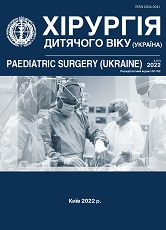Biomechanical rationale for choosing a means of fixation of bone fragments during proximal osteotomy of the first metatarsal bone
DOI:
https://doi.org/10.15574/PS.2022.77.68Keywords:
juvenile, foot, first toe, deformity, osteotomyAbstract
One of the most common pathologies that occurs in static deformities of the anterior joint of the foot in the foot is valgus deformity of the first toe. Distal or diaphyseal osteotomies are used for mild degrees, and proximal osteotomies for severe ones. Spikes, screws or plates with angular stability are most often used to fix bone fragments.
Purpose - with the help of biomechanical studies, to study the stress-deformed state of the foot model with different options for osteosynthesis of the first metatarsal bone after the proximal osteotomy.
Materials and methods. Mathematical modeling of osteosynthesis of the first metatarsal bone during correction of valgus deformity of the first toe using proximal osteotomy was carried out. Three variants of osteosynthesis were modeled: Kirschner pins, screws, and a bone plate.
Results. During osteosynthesis with spikes, maximum stresses of 2.1 MPa occur in distal fragment. In the proximal fragment, the stresses are twice as low - 1.2 MPa. The tension in the resection zone is 0.1 MPa. During osteosynthesis with screws, the stresses in the proximal and distal fragments of the bone are almost the same, and are 0.9 MPa and 0.8 MPa, respectively. The tension in the osteotomy zone is 0.1 MPa. Osteosynthesis with a bone plate provides a low level of stresses in the osteotomy zone - 0.1 MPa, as well as an even distribution of stresses between the proximal and distal fragments of the metatarsal bone - 0.8 MPa and 0.7 MPa, respectively.
During osteosynthesis with spikes and screws, the relative deformation of the bone regenerate does not exceed 0.13%. During osteosynthesis with a bone plate, this figure reaches 0.5%.
Conclusions. For osteosynthesis of bone fragments during proximal osteotomy of the first metatarsal bone in order to eliminate valgus deformity of the first toe, spikes, screws and a bone plate can be used. All investigated types of osteosynthesis provide a low level of stress in the osteotomy zone of the first metatarsal bone, but, according to the criterion of stress values in the proximal and distal fragments of the bone, osteosynthesis with spikes showed the worst result, and osteosynthesis with a bone plate showed the best.
The research was carried out in accordance with the principles of the Helsinki Declaration. The study protocol was approved by the Local Ethics Committee of the participating institution. The informed consent of the patient was obtained for conducting the studies.
No conflict of interests was declared by the authors.
Keywords: juvenile, foot, first toe, deformity, osteotomy.
References
Alyamovskiy AA. (2004). SolidWorks / COSMOSWorks. Inzhenernyy analiz metodom konechnykh elementov. Moskow: DMK Press: 432.
Berezovskiy VA, Kolotilov NN. (1990). Biofizicheskiye kharakteristiki tkaney cheloveka. Spravochnik. Kyiv. Naukova dumka: 224.
Coughlin MJ, Carlson RE. (1999). Treatment of hallux valgus with an increased distal metatarsal articular angle: evaluation of double and triple first ray osteotomies. Foot Ankle Int. 20: 762-770. https://doi.org/10.1177/107110079902001202; PMid:10609703
Coughlin MJ. (1996). Hallux valgus. J. Bone Joint Surg. Am. 78: 932-966. https://doi.org/10.2106/00004623-199606000-00018
Croitoru GM, Betisor VK, Darchuk MI. (2003). SCARF osteotomy in the surgical treatment of valgus deformity of the first toe. Orthopaedics, Traumatology and Prosthetics. 3: 113-114.
Gere JM, Timoshenko SP. (1997). Mechanics of Material: 912.
Goforth WP, Martin JE, Domrose DS et al. (1996). Austin bunionectomy using single screw fixation: five-year versus 18-month follow-up findings. J. Foot Ankle Surg. 35: 255-259. https://doi.org/10.1016/S1067-2516(96)80107-4; PMid:8807487
Khlopas H, Fallat LM. (2020). Correction of Hallux Abducto Valgus Deformity Using Closing Base Wedge Osteotomy: A Study of 101 Patients. J. Foot and Ankle Surgery. 59 (5): 979-983. https://doi.org/10.1053/j.jfas.2020.04.007; PMid:32622674
Korolkov O, Rakhman P, Karpinsky M, Shishka I, Yaresko O. (2017). Assessment of stress-strain distribution in flatfoot deformity (part 1). Orthopaedics, Traumatology and Prosthetics. 4: 80-84. https://doi.org/10.15674/0030-59872017480-84
Korolkov O, Rakhman P, Karpinsky M, Shishka I, Yaresko O. (2018). Characteristics of stress-strain foot model before and after subtalar arthroereisis with implants at the treatment of flatfoot (message 2). Orthopaedics, Traumatology and Prosthetics. 1: 65-71. https://doi.org/10.15674/0030-59872018165-71
Obraztsov IF, Adamovich IS, Barer IS et al. (1988). Problema prochnosti v biomekhanike. Uchebnoye posobiye dlya tekhnich. i biol. spets. VUZov. Moskow: Vyssh. shkola: 311.
Popsuyshapka OK. (1991). Funktsional'noye lecheniye diafizarnykh perelomov kostey konechnostey (klinicheskoye i eksperimental'noye obosnovaniye). Doctoral dissertation. Kharkív: Sytenko Institute of Spine and Joints Pathology of the NAMS of Ukraine.
Prozorovsky DV, Romanenko KK, Goridova LD, Ershov DV. (2012). The choice of fixation method for proximal osteotomy of the first metatarsal bone. Trauma. 13: 3.
Shyshka IV, Korolkov OI, Karpinskyi MIu, Yaresko OV. (2021). Matematychne modeliuvannia napruzheno-deformovanoho stanu elementiv stopy v umovakh hipoplazii lateralnoi kistochky. Ortopedyia, travmatolohyia y protezyrovanye. 4: 49-57. https://doi.org/10.15674/0030-59872021449-57
Zenkevich OK. (1978). Metod konechnykh elementov v tekhnike. Moskow: Mir: 519.
Downloads
Published
Issue
Section
License
Copyright (c) 2022 Paediatric Surgery (Ukraine)

This work is licensed under a Creative Commons Attribution-NonCommercial 4.0 International License.
The policy of the Journal “PAEDIATRIC SURGERY. UKRAINE” is compatible with the vast majority of funders' of open access and self-archiving policies. The journal provides immediate open access route being convinced that everyone – not only scientists - can benefit from research results, and publishes articles exclusively under open access distribution, with a Creative Commons Attribution-Noncommercial 4.0 international license(СС BY-NC).
Authors transfer the copyright to the Journal “PAEDIATRIC SURGERY.UKRAINE” when the manuscript is accepted for publication. Authors declare that this manuscript has not been published nor is under simultaneous consideration for publication elsewhere. After publication, the articles become freely available on-line to the public.
Readers have the right to use, distribute, and reproduce articles in any medium, provided the articles and the journal are properly cited.
The use of published materials for commercial purposes is strongly prohibited.

